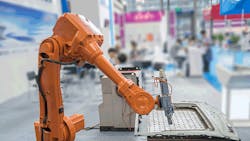Let's Settle This: Is Automation Good for Workers or Not?
Which picture more accurately describes the impact of automation on a workforce: an orchestrated collaboration between man and machine, or a worker being shown the door as the robot takes over his job?
Probably both.
Arguments line up on both sides. A recent survey by Accenture extols the virtues of the "connected workforce" which can elevate employees' work lives as they take on more value-added responsibilities while the robot does the repetitive tasks.
Not everyone would agree with that. Warehouse workers who might have been hired to sort and pick are being replaced with robots. In fact online retailer Amazon now has 30,000 robots at 13 fulfillment centers and intends to add more. A more skeptical way to look at this situation is that with 90,000 employees, one in four warehouse workers is a robot.
And these warehouse robots are set to gain new skills as well. A robot called Freight, developed by Fetch Robotics, currently works alongside employees and assists them as they pick products. While that sounds cozy and can aid workers, the story doesn't end there as the company is developing a robot that can take the merchandise off the shelves without a human.
Amazon is also looking to develop this type of robot. But the company insists that its fulfillment centers will not be devoid of humans but instead will be a "symphony of robotics, software, of people and of high-tech computer science algorithms—machine learning everywhere—and our employees are key to the process," the company said, as reported by Todd Bishop of GeekWire. "There has been no job loss associated with the use of robotics in our buildings and in fact due to increased efficiencies, some of our buildings utilizing robotics have the highest headcounts in our network."
Perhaps the high headcounts have more to do with the increase in e-commerce business than with automation.
But express delivery company DHL would agree with Amazon's vision of humans and robots happily sharing a work environment. "Just like our children can't picture a world without computers, it is likely that their children will feel the same way about robots," explains Clemens Beckmann, executive vice president innovation, Post–eCommerce–Parcel at Deutsche Post DHL. "Developing the next generation of robots that can work around and among people will take a substantial investment to advance the technology but we believe that soon supply chains will see humans and robots working side by side to handle goods faster and more economically."
This collaborative arrangement will last for quite a while, according to DHL, since 80% of current warehouses are manually operated with no supporting automation.
While the warehouse world catches up on automation, I would have to believe that employees who held those routine, less-skilled jobs will be eliminated unless companies retrain them for more skilled jobs within the company. Software engineers are already moving very rapidly to teach robots new skills. Advanced robots are gaining enhanced senses and dexterity, allowing them to perform a broader scope of manual tasks, according to a recent study by the University of Oxford's Carl Benedikt Frey and Michael A. Osborne.
"Algorithms for Big Data are now rapidly entering domains reliant upon pattern recognition," they note, "and can readily substitute for labor in a wide range of non-routine cognitive tasks."
There is precedent for moving workers out of one type of job to another. In the manufacturing world you can look to the implementation of lean. While some companies laid off workers due to improvements that were a direct result of implementing the lean philosophy, others moved those workers into continuous improvement roles, which in fact are more value added. Training became a rallying flag around which employees could learn, through a specific process, and rewarded with increasing skills (and belts).
Why not take this same approach in the warehouse? Why not create a path to increasing skills levels that are needed to leverage automation to improve a company's competitiveness?
It's my contention that it's the training—or re-training—of workers that will ultimately answer the question of whether automation will drive massive labor loss. But we'd better figure this out quickly.
